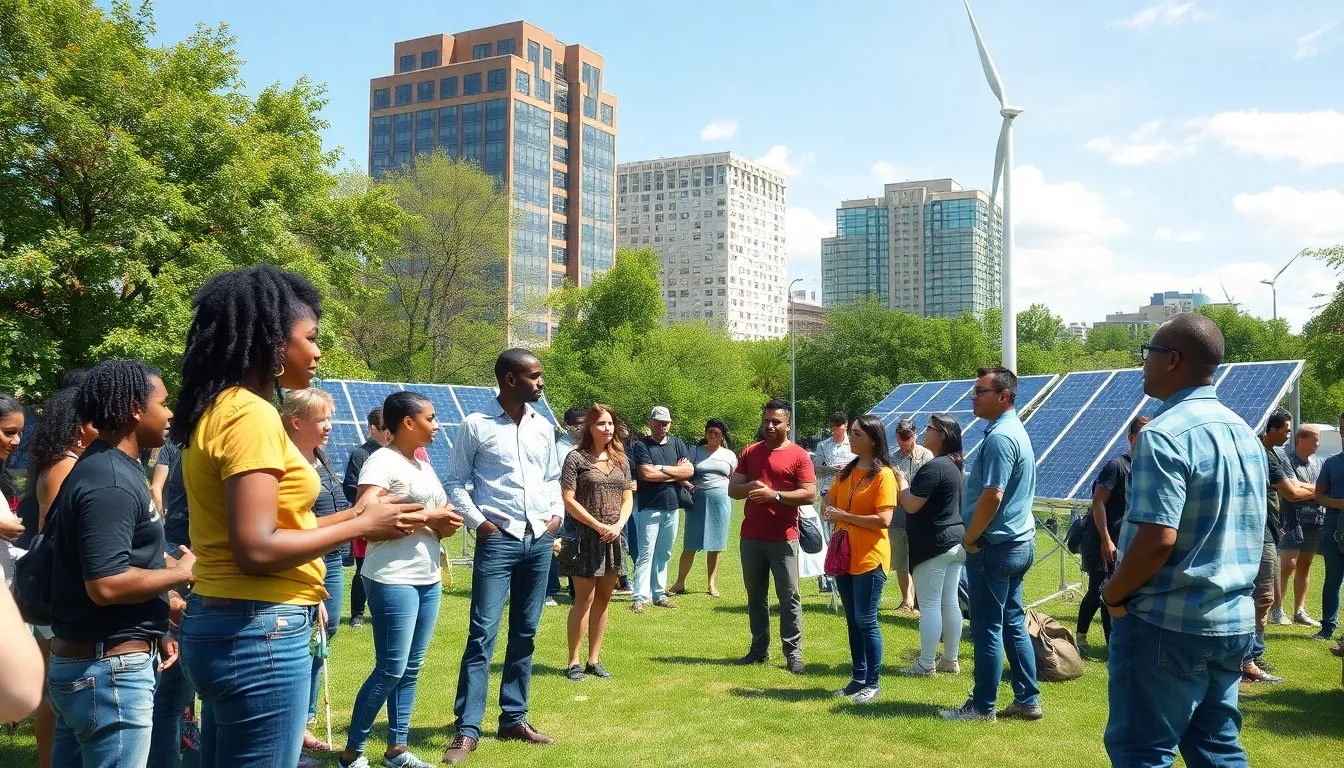Table of Contents
ToggleIn a world increasingly aware of environmental challenges, sustainable technology emerges as a beacon of hope. This innovative approach blends cutting-edge advancements with eco-friendly practices, aiming to reduce our carbon footprint while enhancing efficiency. As industries evolve, the integration of sustainable solutions becomes crucial for both economic growth and environmental preservation.
From renewable energy sources to waste reduction strategies, sustainable technology is reshaping how businesses operate and consumers interact with the planet. It’s not just about going green; it’s about creating a resilient future where technology and nature coexist harmoniously. Understanding the impact and potential of these advancements is essential for anyone looking to make informed choices in today’s rapidly changing landscape.
Overview of Sustainable Technology
Sustainable technology refers to innovative solutions designed to minimize environmental impact while maximizing efficiency. This concept integrates technology with eco-friendly practices across various sectors. Businesses leverage renewable energy sources, such as solar and wind power, to reduce reliance on fossil fuels.
Sustainable materials, like biodegradable plastics and recycled metals, emerge as alternatives to traditional materials. They play a crucial role in eco-conscious manufacturing processes. Innovations in energy efficiency enhance performance, resulting in lower emissions and reduced waste. For instance, energy-efficient appliances consume less power, lowering operational costs.
Water conservation technologies, including rainwater harvesting systems and wastewater treatment solutions, significantly improve resource management. Smart technologies, such as IoT devices, provide real-time data for optimizing energy usage and tracking environmental impact.
Policy frameworks increasingly support sustainable technology adoption, incentivizing businesses to implement greener practices. Organizations committed to sustainability not only fulfill regulatory requirements but also appeal to environmentally conscious consumers. As markets evolve, the role of sustainable technology becomes central to achieving long-term economic and environmental goals.
Benefits of Sustainable Technology


Sustainable technology offers numerous advantages, impacting both the environment and the economy positively. The integration of eco-friendly practices enhances efficiency while addressing critical environmental concerns.
Environmental Impact
Sustainable technology significantly reduces environmental degradation. Companies using renewable energy sources like solar and wind power cut greenhouse gas emissions, contributing to cleaner air. Biodegradable materials and recycled metals diminish waste in landfills, helping conserve natural resources. Energy-efficient appliances lower energy consumption, further decreasing carbon footprints. Water-saving technologies optimize usage, ensuring the longevity of this precious resource. Smart devices enhance monitoring of energy and water use, promoting responsible consumption patterns.
Economic Advantages
Sustainable technology generates economic benefits for businesses and communities. Companies adopting green practices realize cost savings through reduced energy expenditures and lower waste management costs. Public demand for eco-friendly products creates new market opportunities, driving innovation and job creation. Governments often provide incentives for sustainable practices, such as tax breaks and grants, fostering investment in green technologies. As industries adopt sustainable solutions, the overall economic resilience improves, ensuring long-term growth while preserving the environment.
Types of Sustainable Technology
Sustainable technology encompasses various innovative solutions designed to minimize environmental impact and promote responsible resource use. Below are key categories of sustainable technology that are reshaping industries and improving eco-friendliness.
Renewable Energy Solutions
Renewable energy solutions harness natural resources to generate power. These solutions include:
- Solar Energy: Solar panels convert sunlight into electricity, providing a clean energy source for homes and businesses.
- Wind Energy: Wind turbines capture wind movement to generate electricity, reducing reliance on fossil fuels.
- Hydropower: Hydropower plants use flowing water to produce electricity, significantly cutting carbon emissions compared to traditional energy sources.
- Geothermal Energy: Geothermal systems utilize the earth’s heat for heating and electricity, offering a stable and renewable energy source.
These solutions significantly reduce carbon footprints and are vital for a sustainable future.
Green Building Practices
Green building practices focus on designing and constructing buildings that are environmentally responsible and resource-efficient. Key aspects include:
- Sustainable Materials: Builders use eco-friendly materials, like reclaimed wood and recycled metals, to minimize environmental impact.
- Energy Efficiency: Strategies such as thermal insulation and energy-efficient windows lower energy consumption in buildings.
- Water Conservation Systems: Rainwater harvesting and low-flow fixtures optimize water usage in buildings.
- Smart Building Technology: Automated systems manage energy use efficiently, enhancing comfort while reducing waste.
These practices promote healthier living environments and decrease energy costs.
Sustainable Transportation
Sustainable transportation reduces environmental impact while improving mobility. Notable innovations include:
- Electric Vehicles (EVs): EVs produce zero tailpipe emissions, contributing to cleaner air and decreased greenhouse gas emissions.
- Public Transit Systems: Efficient and well-maintained public transport options reduce traffic congestion and reliance on personal vehicles.
- Biking and Walking Infrastructure: Investments in bike lanes and pedestrian pathways encourage eco-friendly commuting options.
- Biofuels: Derived from organic materials, biofuels provide a renewable energy source for vehicles, reducing dependency on fossil fuels.
These transportation methods foster sustainable urban development and enhance public health.
Challenges in Implementing Sustainable Technology
Implementing sustainable technology presents several challenges that hinder widespread adoption. Key obstacles include cost barriers and technological limitations that organizations face.
Cost Barriers
Cost barriers significantly impact the adoption of sustainable technologies. Initial investments in renewable energy systems, such as solar panels or wind turbines, can be substantial. Examples include the average installation cost of solar systems ranging from $15,000 to $25,000 for homes. Many businesses and consumers find these upfront expenses daunting. Financing options may not always be accessible or favorable, leading to hesitance in committing to sustainable solutions.
Ongoing maintenance costs also contribute to financial concerns. Even when investment pays off in the long term through reduced energy bills, the upfront financial burden remains a psychological obstacle. Additionally, industries that heavily rely on traditional energy sources may experience resistance to change, as existing infrastructure has already been established.
Technological Limitations
Technological limitations can restrict the effectiveness of sustainable technology implementations. Current renewable energy systems often depend on specific geographic and climatic conditions. For example, solar energy generation declines in areas with limited sunlight, while wind farms require consistent wind patterns.
Furthermore, energy storage technologies, such as batteries, lag behind in efficiency and capacity. Many lithium-ion batteries used in electric vehicles and for energy storage have limitations regarding lifespan and environmental impact during disposal. Innovations in energy-efficient appliances may not yet reach the same standards as conventional counterparts, reducing incentive for adoption.
Integration challenges arise when combining new technologies with outdated systems. Compatibility issues and the need for specialized expertise can create additional barriers. Overall, advancing sustainable technologies requires overcoming these cost and technological hurdles for broader acceptance and integration.
Future Trends in Sustainable Technology
Emerging trends in sustainable technology focus on innovations that further enhance efficiency and reduce ecological footprints. These trends include advanced energy storage solutions, smart grids, and circular economy models.
Energy Storage Solutions
Energy storage technologies are critical for maximizing renewable energy use. Developments in battery technology, particularly lithium-ion, are improving energy retention and accessibility, making solar and wind power more reliable. Companies are investing in alternative materials, such as solid-state batteries, to increase safety and efficiency in energy storage.
Smart Grids
Smart grid technology optimizes electricity distribution and consumption. It integrates advanced communication systems that monitor energy use in real-time. This innovation enables users to adjust their consumption based on energy availability, leading to reduced peak load demands and improved grid reliability.
Circular Economy Models
Circular economy models prioritize waste reduction and resource efficiency. This approach encourages the reuse of materials and the recycling of products at the end of their life cycles. Businesses are increasingly adopting practices that support sustainable sourcing, product redesign, and take-back initiatives, minimizing waste in landfills.
Sustainable Agriculture Technologies
Sustainable agriculture technologies improve food production while minimizing environmental impact. Innovations include precision farming tools, which utilize data analytics and sensor technologies to enhance crop yields and reduce chemical usage. Vertical farming systems also emerge as solutions to urban agricultural challenges, ensuring local food supply with lower land requirements.
Green Transportation Innovations
Green transportation innovations focus on reducing emissions and improving urban mobility. Developments in electric vehicles (EVs) continue to grow, with increased charging infrastructure supporting their adoption. Additionally, advancements in public transit technologies enhance vehicle efficiency and accessibility for commuters, promoting eco-friendly travel options.
Sustainable Smart Cities
Sustainable smart cities integrate technology to enhance urban living while minimizing environmental impact. Smart building technologies employ energy-efficient materials, automated systems, and renewable energy sources. Additionally, urban planning incorporates green spaces and sustainable transport options to promote a healthier environment for residents.
Policy and Regulatory Developments
Regulatory frameworks are evolving to support sustainable technology initiatives. Governments are implementing policies that encourage investment in renewable energy, energy efficiency, and sustainable practices. These policies often include subsidies, tax incentives, and stricter emissions regulations, fostering innovation and growth in sustainable technologies.
These future trends in sustainable technology signal a significant shift towards an eco-conscious approach in various industries. Continuous advancements promise to drive efficiency, reduce emissions, and promote environmentally responsible practices.
Sustainable technology is paving the way for a greener future. By integrating innovative solutions with eco-friendly practices, industries are not only cutting emissions but also enhancing efficiency. The shift towards renewable energy and sustainable materials is crucial for reducing environmental impact.
As businesses embrace these technologies, they unlock economic benefits while responding to public demand for eco-conscious products. The challenges ahead require collaboration and commitment from all sectors. With ongoing advancements and supportive policies, the potential for sustainable technology to transform our world is immense. Embracing this evolution is essential for a healthier planet and a thriving economy.







